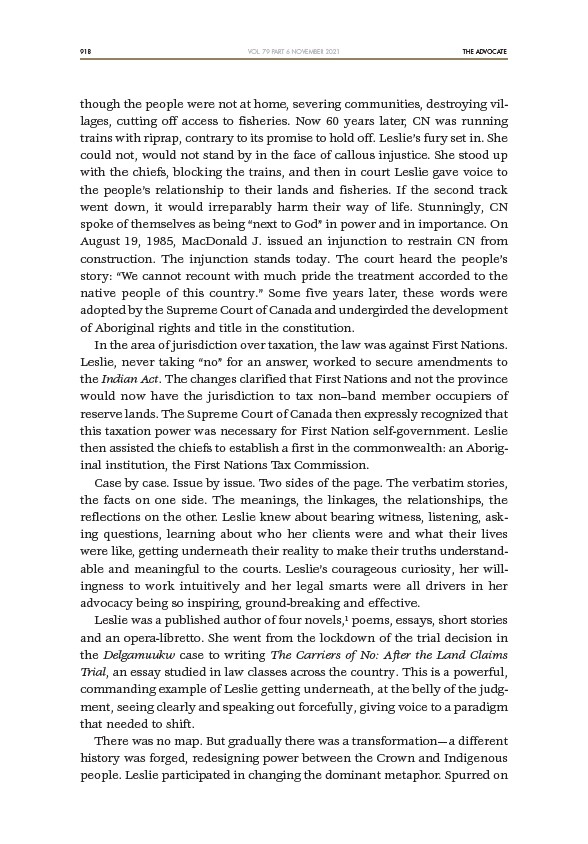
918 THE ADVOCATE
VOL. 79 PART 6 NOVEMBER 2021
though the people were not at home, severing communities, destroying villages,
cutting off access to fisheries. Now 60 years later, CN was running
trains with riprap, contrary to its promise to hold off. Leslie’s fury set in. She
could not, would not stand by in the face of callous injustice. She stood up
with the chiefs, blocking the trains, and then in court Leslie gave voice to
the people’s relationship to their lands and fisheries. If the second track
went down, it would irreparably harm their way of life. Stunningly, CN
spoke of themselves as being “next to God” in power and in importance. On
August 19, 1985, MacDonald J. issued an injunction to restrain CN from
construction. The injunction stands today. The court heard the people’s
story: “We cannot recount with much pride the treatment accorded to the
native people of this country.” Some five years later, these words were
adopted by the Supreme Court of Canada and undergirded the development
of Aboriginal rights and title in the constitution.
In the area of jurisdiction over taxation, the law was against First Nations.
Leslie, never taking “no” for an answer, worked to secure amendments to
the Indian Act. The changes clarified that First Nations and not the province
would now have the jurisdiction to tax non–band member occupiers of
reserve lands. The Supreme Court of Canada then expressly recognized that
this taxation power was necessary for First Nation self-government. Leslie
then assisted the chiefs to establish a first in the commonwealth: an Aboriginal
institution, the First Nations Tax Commission.
Case by case. Issue by issue. Two sides of the page. The verbatim stories,
the facts on one side. The meanings, the linkages, the relationships, the
reflections on the other. Leslie knew about bearing witness, listening, asking
questions, learning about who her clients were and what their lives
were like, getting underneath their reality to make their truths understandable
and meaningful to the courts. Leslie’s courageous curiosity, her willingness
to work intuitively and her legal smarts were all drivers in her
advocacy being so inspiring, ground-breaking and effective.
Leslie was a published author of four novels,1 poems, essays, short stories
and an opera-libretto. She went from the lockdown of the trial decision in
the Delgamuukw case to writing The Carriers of No: After the Land Claims
Trial, an essay studied in law classes across the country. This is a powerful,
commanding example of Leslie getting underneath, at the belly of the judgment,
seeing clearly and speaking out forcefully, giving voice to a paradigm
that needed to shift.
There was no map. But gradually there was a transformation—a different
history was forged, redesigning power between the Crown and Indigenous
people. Leslie participated in changing the dominant metaphor. Spurred on